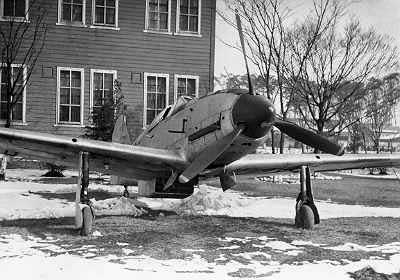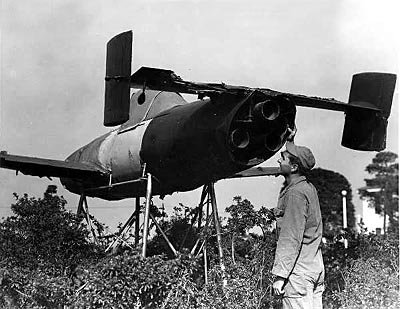Curtis LeMay had been sent to the Marianas to get results. So far conventional high altitude bombing had not produced the desired results. The weather at altitude was rendering results sometimes useless. He realized he needed a complete change in strategy. The big change he envisioned was to change the altitude to get them out of the jet stream, and also save considerable gas. He also decided he would firebomb every city in Japan. In 1944 a group of manufacturers including Standard Oil and Du Pont came up with a jellied gasoline called napalm. It would stick to anything and set ferociously hot fires. Gen. Thomas Power, Commander of the 314th Bombardment Wing, carried out a fire raid test over Tokyo. Bombs were dropped from 25,000 ft. and burned out a full square mile. He reported to LeMay that he thought by going in at the lower altitude with a larger bomb load there would have been much greater destruction.Then came the radical decision by LeMay. The planes would go in at 10,000 ft. He ordered the removal of bomb bay fuel tanks claiming by not going to altitude they would not need the gas. All .50 cal. Guns would be removed, and all ammo. With no guns the gunners did not need to go. They would approach at night, low, not in formation but singly, each plane now carrying twice the previous bomb load. LeMay knew his job depended on this radical decision, and he also knew his tactics would kill thousands of civilians. How many Americans would be killed in an invasion of Japan? It was to be a huge gamble. His crews reacted negatively when told. They claimed they were being sent on a suicide mission. LeMay replied "if this raid works the way I think it will, we can shorten the war". On March 9, 334 B-29s took off from Guam, arriving in Japan under good weather conditions. The planes were stacked up from 4,900 ft. to 9,200 ft. They dropped one 500 pound cluster of fire bombs every 50 feet. The target area was 3 by 5 miles, containing a large industrial complex, however each square mile held over 100,000 civilians. The bombs fell, and within thirty minutes the resulting fires were out of control, driven by 40 mph winds. Tokyo, hit by strings of incendiaries, became a holocaust. Water boiled in the canals after the temperature reached over 1800 degrees F. For three hour the B-29s kept coming. Only a few fighters appeared causing little damage. We lost 14 planes with damage to 42. An official Japanese count reported nearly 84,000 killed, 41,000 injured, and over 250,000 buildings destroyed in this one raid. 16 square miles burned out. The Japanese called the raid "Slaughter bombing". LeMay was driving his crews to exhaustion, as he launched four more raids in the next eight days against Osaka, Kobe, and twice on Nagoya. In only five raids the B-29s wiped out 32 square miles in four major cities. The population of Tokyo dropped to half as panic stricken civilians fled. Washington was finally satisfied that fire bombing was the answer to crushing the Japanese , and sent LeMay a list of 33 additional Industrial targets, and gave the resupply of incendiaries to XXI Bomber Command the highest priority.
The bombing of Kobe was a little different. Napalm bombs were in short supply so 2,355 tons of magnesium thermite bombs were used. The thermite bombs burned with an intensity of 2300 degrees F. Three square miles were incinerated and substantial damage was done to the aircraft plant, dock area, and the Kawasaki shipyards which built submarines. The morale of the Japanese people hit bottom as industries were wiped out, and city populations dropped.
This meant ramming if necessary, as suicide was considered an honorable death. The aircraft were not all that bad. I spent many hours going over a "Tony", and while some of the workmanship was crude the plane was more than adequate.


click images for larger view
Similar in appearance to a P-51, it had good top speed, and was armed with cannons. The one thing the Japanese fighter lacked was the ability to go to altitude, making the B-29 in many instances inaccessible to them. The twin engined Ki-45 "Dragon Killer" was a successful night fighter fitted with a unique and deadly cannon arrangement.
It had twin 20mm cannons mounted about mid section, and tilted upward. By flying under a bomber formation, relatively safe from B-29 fire, they could raise havoc by firing up into the formation. This tactic was used mostly at night. During the day the Japanese pilots attacked head on firing at the cockpit. With 1700 of these aircraft with speeds over 340mph they were a problem to be reckoned with. The single engine fighter was in great abundance, however due to the B-29 raids Japan was running out of qualified pilots, mechanics, fuel, and parts.
 JAPANESE ZERO (Modified AT6) ctsy Webshots click image for larger view |
The Zero is perhaps the best known fighter because of its maneuverability, and actually became legendary. Possibly the most effective was the "Tony" which I mentioned previously. Called the Swallow, it had self sealing gas tanks and cockpit armor. The barrel shaped Mitsubishi J2M "Jack" was also a formidable plane.
The continued pounding by the B-29s was at first aimed at aircraft and engine plants. Japan faced a shortage of raw materials, steel, aluminum, and their parts inventory was sparse. Later when the P-51 accompanied the B-29s Japanese planes were destroyed at an astounding rate, putting a strain on the entire war effort.
 JAPANESE "KATE" DIVE BOMBER (Modified AT6) ctsy Webshots click images for larger view |
As Japan became more desperate the war turned into a frantic struggle. The ingenious methods used by the Japanese now involved a "do or die" attitude, realizing they were nearing defeat. Ramming attempts were increased. Another variation of unique ideas was the dropping of phosphorous bombs from aircraft flying above the bomber formation. Another was connecting a chain to several smaller bombs and dropping them onto the bombers, hoping the chain would wrap around the propellers. Searchlights were mostly ineffective as compared to the Germans. Anti-aircraft fire was a mixture of good and bad. It got better later in the war as heavier guns were brought in. Badly needed was a radar control system that worked. The Japanese had developed a rocket propelled "torpedo" called the Baka Bomb.
  |
| BAKA ROCKET PROPELLED SUICIDE BOMB Photo by W.Mayo click images for larger view |
It was a suicide bomb dropped from a mother plane flying above the B-29s. I have read reports that flying time was about five minutes, diving at speeds approaching 600mph. My examination of this "human guided missile" made me wonder how it stayed together at that speed. Of course there was no way for the pilot to change his mind as he was sealed inside. It was indeed a fearsome sight to see this rocket headed for a formation of bombers with intentions to ram. We are fortunate the Japanese never perfected this weapon to a higher level. So the Japanese fighter plane with all it's imperfections caused severe damage to our attacking forces.
Operation "starvation" was the final blow to the Japanese supplies. With their aircraft factories burned out, and a major shortage of everything, B-29s roamed the skies at will along with Navy fighters and P-51s. It was obvious that the Japanese effort to defend Japan had come to an end. In spite of all this the Japanese soldier was told and firmly believed that supplies and ammo were on the way. He was ready to fight to his death defending his country. However, the Japanese air-defense system had virtually ceased to exist.